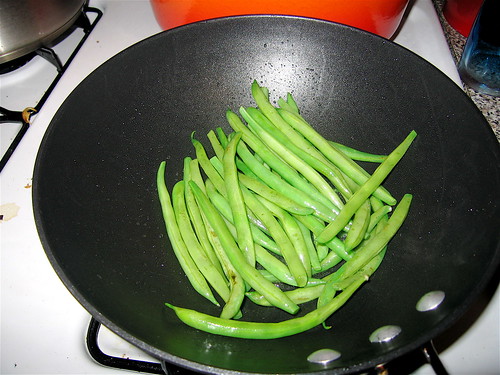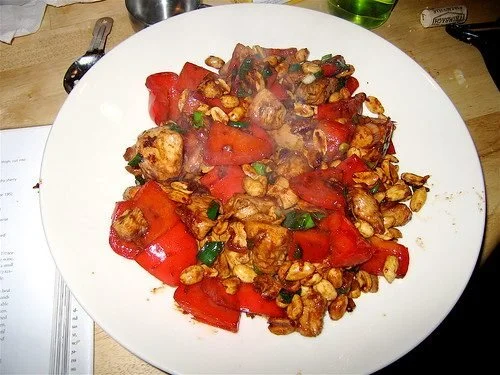Big Trouble, Little China: A Post in Which I Cook Kung Pao Chicken & Dry-Fried Sichuan String Beans
Last year I bought a Chinese cookbook--The Breath of a Wok by Grace Young and Alan Richardson--and for a full year I ignored it, swept it under the rug, hoped it would disappear. On one hand I really wanted to attempt Chinese cooking, but then a million take-out menus, Canal street stops on the subway and frequent visits to Grand Sichuan convinced me otherwise. With so much good Chinese food readily available here in New York, why should I try to cook it? And furthermore, how could I use a cookbook called "The Breath of a Wok" if I didn't have a wok?
I did have a mock-wok (ha, that's a funny expression.) My friend Mark sent me one long ago; it's a Calphalon wok-shaped pan. It'd been sitting in my drawer just as neglected as my Chinese cookbook. One day the Department of Cruelty to Food Related Products protested outside my apartment with placards that read: "Unfair To Chinese Cookbooks and Chinese Cooking Accessories." I finally broke down and decided I would attempt something. And what I attempted is the dish you see above: Kung Pao Chicken.
It didn't come out that great.
It says you can use chicken thighs or breasts and I couldn't find humane thighs at Key Foods the day I made this, so I bought humane breasts. All this morality makes Chinese cooking difficult (which is why, come to think of it, ordering Chinese food is such an indulgence: we don't have to think about where everything comes from). The breasts, predictably, made the dish less flavorful, a bit too dry.
You cut 1 pound skinless boneless chicken breasts (or thighs) into 3/4 inch cubes and then marinate the cubes in 2 teaspoons of soy sauce, 1 teaspoon rice wine, 2 teaspoons cornstarch, and 1/2 teaspoon sugar. Set aside. In another bowl combine 2 Tbs chicken broth, 2 teaspoons balsamic vinegar, and 1 Tbs rice wine and 2 teaspoons soy sauce.
Meanwhile toast peanuts (3/4 cup shelled, raw peanuts) in the oven, about 7 to 10 minutes at 375.
Then you heat a 14-inch flat-bottomed wok or, in my case, a 12-inch saute pan (I didn't use my mock-wok here because it wouldn't've browned all the chicken at once) until "a bead of water vaporizes within 1 to 2 seconds of contact." You swirl in 1 Tbs of vegetable oil, and then add 2 Tbs minced garlic, 2 Tbs minced ginger, and 2 dried red chiles and stir fry 20 seconds. Then you add the chicken mixture, spreading evenly in the pan (or wok):

This kind of cooking is fun because it's high octane cooking: it all happens very fast. You let the chicken brown for a minute, and then stir fry a minute and then, when it's browned on all sides, you transfer to a plate.
Then you swirl in remaining 1 Tbs of oil and add 2 large red bell peppers cut into 1-inch cubes and stir-fry until softened (1 minute). Then you return the chicken to the pot and add the broth mixture, which you swirl into the wok and stir fry 1 minute while scooping up all the brown bits fom the bottom. Then you add peanuts, salt, and chopped scallions, stir-fry 30 seconds, discard chiles and serve.
Actually, when I think back on this dish, it was pretty good. I think it's unfair to judge it based on my experience because of my wok-less approach. That's sort of like judging a DVD player based on how well it plays a VHS tape. (huh?)
The more successful recipe, though, was this one for Dry-Fried Sichuan String Beans. This is one of Craig's and my favorite dishes at Grand Sichuan and it's really easy to reproduce at home. Here's what you need:
1/4 cup Homemade Chicken Broth
1 Tablespoon sugar
1 teaspoon salt
4 tablespoons vegetable oil
1 pound string beans or Chinese long beans
2 tablespoons minced ginger
2 ounces ground pork (about 1/4 cup)
1 Tablespoon Chinkiang or balsamic vinegar
1 teaspoon sesame oil
1 Tablespoon chopped scallion

1. In a bowl combine the broth, sugar and salt.
2. Heat a 14-inch flat-bottomed wok over high heat until a bead of water vaporizes within 1 to 2 seconds of contact. Swirl in 2 Tablespoons of the vegetable oil and add half the beans.

[That's my mock-wok.]
Reduce the heat to medium and pan-fry, turning the beans with a metal spatula, until they have brown spots and begin to wrinkle, 3 to 4 minutes. Transfer to a plate with a slotted spoon. Pan-fry the remaining beans with 1 tablespoon of the vegetable oil in the same manner.
3. If the unwashed wok is dry, swirl in the remaining 1 Tablespoon vegetable oil over medium heat. Add the ginger and ground pork and stir-fry until the pork is no longer pink, breaking up the pork with a spatula, about 1 minute. Stir the broth mixture and swirl it into the wok. Bring to a boil over high heat and add the beans, tossing to combine, and cook until most of the liquid has evaporated, 1 to 2 minutes. Add the vinegar, sesame oil, and scallion and remove from the heat. Serve at room temperature.

That last picture should get you excited, especially if you've had the same dish at Grand Sichuan. It's really a cinch to make at home and you'll be glad you did.
Will I be doing this again? Ok, well next time I go to Chinatown I'm going to buy a wok. And once I have that wok maybe I will crack open the pages of this book again, to try it the right way. Unless I put the wok under my sink and the book back on the shelf and neglect them for years and years, turning instead to the menus, Canal street, Grand Sichuan. How can Chinese home cooking prevail when there's so much Chinese goodness just a phone call or a subway ride away?

